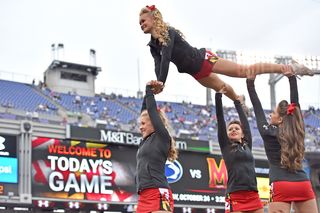High-School Cheerleading Injuries Are Often Severe

High school cheerleaders have an overall rate of injuries that is lower than that of most other high school sports, but the injuries that do occur among cheerleaders tend to be more severe, a new study suggests.
In the study of 22 high school sports, there were 17 sports that had higher injury rates than cheerleading, the researchers found. However, cheerleading ranked second, right behind gymnastics, among all sports in the study for the proportion of injuries that caused athletes to be benched for at least three weeks, they found.
"Although overall injury rates are relatively low, cheerleading injuries may be more severe when they do occur," the researchers, from the Colorado School of Public Health and the University of Colorado, wrote in their study, published today (Dec. 10) in the journal Pediatrics.
In the study, the researchers examined data from a national high school sports injury surveillance system gathered between 2009 and 2014. They found that, of all of the injuries from cheerleading, concussions were the most common, constituting 31 percent of the injuries. [9 Weird Ways Kids Can Get Hurt]
Nearly 70 percent of cheerleaders' concussions occurred during stunts (such as when one cheerleader is lifted onto another's shoulders), whereas 16 percent occurred during pyramid formations and 9 percent occurred during tumbling. Most concussions that occurred during stunts and pyramid formations were caused by contact with another person — most commonly, getting elbowed by someone. Most concussions from tumbling resulted from bumping the head on the floor, the researchers said.
About 46 percent of all cheerleading injuries occurred in cheerleaders who were at the base of formations for stunts and pyramids, followed by 36 percent that occurred in fliers (those in the upper levels of the pyramid) and 10 percent that occurred in spotters.
Of all cheerleading injuries, about 34 percent resulted in cheerleaders returning to their sport in less than one week, and another 41 percent allowed them to return in one to three weeks. But about 11 percent of the injuries kept a cheerleader sidelined for three weeks or more, and about 5 percent ended either their season or their career. The type of injury that most commonly resulted in a time loss of three weeks or more was a concussion, the researchers said.
Sign up for the Live Science daily newsletter now
Get the world’s most fascinating discoveries delivered straight to your inbox.
Evidence-based efforts to prevent injuries in cheerleaders should focus on specific activities that put cheerleaders at risk for severe injuries, the researchers recommended.
Follow Agata Blaszczak-Boxe on Twitter. Follow Live Science @livescience, Facebook & Google+. Originally published on Live Science.
